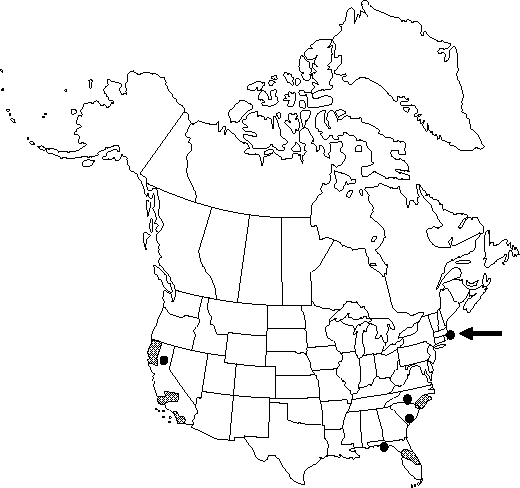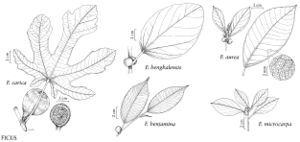Difference between revisions of "Ficus carica"
Sp. Pl. 2: 1059. 1753.
FNA>Volume Importer |
imported>Volume Importer |
||
| (7 intermediate revisions by 2 users not shown) | |||
| Line 9: | Line 9: | ||
|common_names=Common fig | |common_names=Common fig | ||
|special_status={{Treatment/ID/Special_status | |special_status={{Treatment/ID/Special_status | ||
| + | |code=W1 | ||
| + | |label= | ||
| + | }}{{Treatment/ID/Special_status | ||
|code=F | |code=F | ||
| − | |label= | + | |label=Illustrated |
| − | |||
| − | |||
| − | |||
}}{{Treatment/ID/Special_status | }}{{Treatment/ID/Special_status | ||
|code=I | |code=I | ||
| Line 27: | Line 27: | ||
}}<!-- | }}<!-- | ||
| − | --><span class="statement" id="st- | + | --><span class="statement" id="st-undefined" data-properties=""><b>Shrubs </b>or small trees, deciduous, to 5 m. <b>Roots</b> not adventitious. <b>Bark</b> grayish, slightly roughened. <b>Branchlets</b> pubescent. <b>Leaves</b>: stipules 1-1.2 cm; petiole 8-20 cm. <b>Leaf</b> blade obovate, nearly orbiculate, or ovate, palmately 3-5-lobed, 15-30 × 15-30 cm, base cordate, margins undulate or irregularly dentate, apex acute to obtuse; surfaces abaxially and adaxially scabrous-pubescent; basal veins 5 pairs; lateral veins irregularly spaced. <b>Syconia</b> solitary, sessile, green, yellow, or red-purple, pyriform, 5-8 cm, pubescent; peduncle ca. 1 cm; subtending bracts ovate, 1-2 mm; ostiole with 3 subtending bracts, umbonate.</span><!-- |
-->{{Treatment/Body | -->{{Treatment/Body | ||
| Line 33: | Line 33: | ||
|habitat=Disturbed sites | |habitat=Disturbed sites | ||
|elevation=0-300 m | |elevation=0-300 m | ||
| − | |distribution=Calif.;Fla.;Mass.;N.C.;S.C.;Mexico;West Indies;native to Asia | + | |distribution=Calif.;Fla.;Mass.;N.C.;S.C.;Mexico;West Indies;native to Asia. |
| − | |discussion=<p>Ficus carica is known to escape in Alabama, Louisiana, Texas, Virginia, and West Virginia, although no specific localities are documented.</p><!-- | + | |introduced=true |
| − | --><p>Ficus carica was first known from Caria in southwestern Asia. It is cultivated for its edible fruit and becomes established outside of cultivation only sporadically in the United States. It can sometimes be found persisting around old habitations and old orchards.</p> | + | |discussion=<p><i>Ficus carica</i> is known to escape in Alabama, Louisiana, Texas, Virginia, and West Virginia, although no specific localities are documented.</p><!-- |
| + | --><p><i>Ficus carica</i> was first known from Caria in southwestern Asia. It is cultivated for its edible fruit and becomes established outside of cultivation only sporadically in the United States. It can sometimes be found persisting around old habitations and old orchards.</p> | ||
|tables= | |tables= | ||
|references= | |references= | ||
| Line 44: | Line 45: | ||
-->{{#Taxon: | -->{{#Taxon: | ||
name=Ficus carica | name=Ficus carica | ||
| − | |||
|authority=Linnaeus | |authority=Linnaeus | ||
|rank=species | |rank=species | ||
| Line 54: | Line 54: | ||
|habitat=Disturbed sites | |habitat=Disturbed sites | ||
|elevation=0-300 m | |elevation=0-300 m | ||
| − | |distribution=Calif.;Fla.;Mass.;N.C.;S.C.;Mexico;West Indies;native to Asia | + | |distribution=Calif.;Fla.;Mass.;N.C.;S.C.;Mexico;West Indies;native to Asia. |
|introduced=true | |introduced=true | ||
|reference=None | |reference=None | ||
|publication title=Sp. Pl. | |publication title=Sp. Pl. | ||
|publication year=1753 | |publication year=1753 | ||
| − | |special status= | + | |special status=W1;Illustrated;Introduced |
| − | |source xml=https:// | + | |source xml=https://bitbucket.org/aafc-mbb/fna-data-curation/src/2e0870ddd59836b60bcf96646a41e87ea5a5943a/coarse_grained_fna_xml/V3/V3_409.xml |
|genus=Ficus | |genus=Ficus | ||
|species=Ficus carica | |species=Ficus carica | ||
| − | |||
| − | |||
| − | |||
| − | |||
| − | |||
| − | |||
| − | |||
| − | |||
| − | |||
| − | |||
| − | |||
| − | |||
| − | |||
| − | |||
| − | |||
| − | |||
| − | |||
| − | |||
| − | |||
| − | |||
| − | |||
| − | |||
| − | |||
| − | |||
| − | |||
| − | |||
| − | |||
| − | |||
| − | |||
| − | |||
}}<!-- | }}<!-- | ||
-->[[Category:Treatment]][[Category:Ficus]] | -->[[Category:Treatment]][[Category:Ficus]] | ||
Latest revision as of 21:48, 5 November 2020
Shrubs or small trees, deciduous, to 5 m. Roots not adventitious. Bark grayish, slightly roughened. Branchlets pubescent. Leaves: stipules 1-1.2 cm; petiole 8-20 cm. Leaf blade obovate, nearly orbiculate, or ovate, palmately 3-5-lobed, 15-30 × 15-30 cm, base cordate, margins undulate or irregularly dentate, apex acute to obtuse; surfaces abaxially and adaxially scabrous-pubescent; basal veins 5 pairs; lateral veins irregularly spaced. Syconia solitary, sessile, green, yellow, or red-purple, pyriform, 5-8 cm, pubescent; peduncle ca. 1 cm; subtending bracts ovate, 1-2 mm; ostiole with 3 subtending bracts, umbonate.
Phenology: Flowering spring–summer.
Habitat: Disturbed sites
Elevation: 0-300 m
Distribution

Introduced; Calif., Fla., Mass., N.C., S.C., Mexico, West Indies, native to Asia.
Discussion
Ficus carica is known to escape in Alabama, Louisiana, Texas, Virginia, and West Virginia, although no specific localities are documented.
Ficus carica was first known from Caria in southwestern Asia. It is cultivated for its edible fruit and becomes established outside of cultivation only sporadically in the United States. It can sometimes be found persisting around old habitations and old orchards.
Selected References
None.
